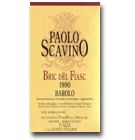15
The King of Wines
Posted by | Posted in Grape Adventures, Wine Reviews | Posted on 12-15-2010
I don’t know much about Barolo. But I want to.
They say that Barolo is “the wine of kings” and the “king of wines.” With that in mind, I figured that I should learn about Barolo from one of the best. No messing around, no new guys and certainly no recent vintage. I wanted a king to teach me Barolo. And so I turned to Paulo Scavino and his 1990 Bric del Fiasc Barolo.
Scavino is certainly one of the kings of Barolo. Paulo, after whom the wine is still named, started making wine in 1921 in Castiglione Falleto, one of the famed townships of Barolo. Today the estate is run by Paulo’s son Enrico.
In fact, it was Enrico who first convinced Paulo that they should vinify the grapes from the Fiasco cru (or vineyard) separately. These Nebiollo grapes were always the best; as such, the Bric del Fiasc became Scavino’s premier bottling.
Barolo is a red DOCG wine produced in the northern Italian region of Piedmont. It is made entirely out of Nebbiolo grapes and is known for its ability to age. Traditionally, the Nebbiolo grapes were pressed and the fermenting wine was left exposed to the skins for three weeks! After that, wine was typically aged in large wooden casks for years. Traditional Barolo is extremely tannic, partially a result of the time the wine spends in contact with the skins, and can therefore age for an extremely long time. But, it also requires serious aging before it is tolerable to taste!
This led to the infamous Barolo wars of the 1970’s and 1980’s. New, modern producers sought to make wine that was more accessible to consumers and did not require such a long time in bottle before it could be drunk. Modernists used new techniques – they shortened the maceration period (the period when fermenting wine is exposed to skins) to days instead of weeks, they used pump overs to attain the wine’s desired color and they aged the wine for shorter periods of time in small, new oak barrels. Historically, Barolo was exposed to the skins for such a long period of time in order to maximize color extraction. Nebbiolo grapes were often harvested unripe with slightly green tannins – this made color extraction key.
In 1990 Scavino was at an intersection of traditional and modern techniques. Maceration took place over twelve to fourteen days, pump overs were still performed manually and the malolactic fermentation was done mostly in small french oak barrels. The wines were then aged in larger casks before being bottled.
Antonio Galloni, of Robert Parker’s Wine Advocate, gave the 1990 Bric del Fiasc an absolutely glowing review in February of this year. He calls the wine “utterly profound,” “rich, dark and sensual” and a “veritable fountain of youth.”
I agree with Galloni that the wine is youthful! There is no debating that; this baby will go another ten to twenty years easy. And it is clearly a very good wine; it’s finish is long and smooth. But for me the wine was still too tannic, despite being twenty years old. It was difficult to drink without food and without the right food, it wasn’t that pleasurable either. However, when paired with braised short ribs the wine really stood out. The sweetness of the short ribs brought out a sweetness in the wine that made the tannins take a backseat to the Nebbiolo grapes. With a pork chop however, the wine was overly tannic and generally overpowering.
It was also interesting to watch the wine evolve over the course of the meal. In hindsight, we drank it too quickly! After an hour and a half in the decanter it improved materially and was almost a different wine. The tannins faded and new flavors emerged – dark fruit and an underlying sweetness.
For me this was a good wine, but not a truly great wine. If I spend $200 on a bottle of wine I want to love it. I want to feel the need to carry it home with me to cradle in bed. And I certainly want to crave another experience with it. I didn’t get those feelings from the ’90 Bric del Fiasc. But I’m no king – perhaps Barolo just isn’t for me.







